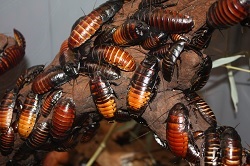 |
| Hissing cockroaches--Courtesy of Ltshears/Commons |
DNA nanorobots that have proven their drug-delivering performance in early in vitro clinical trials have now demonstrated that they can do the same operations in a living cockroach.
A programmed DNA-based robot is one that can carry out an operation--simple or complex--to achieve a desired result. In the case of these DNA "origami" robots, bioengineers at Harvard University's Wyss Institute and Bar-Ilan University in Israel have used the genetic material's binding properties to curl around a compound and uncurl to release the compound at a specific target.
A challenge in the past has been with the complexities of a living organism and the dynamic interactions that occur therein. But by creating nanorobots that can match that complexity by interacting with each other in a way that resembles a much larger computer system, a controlled and elaborate system can be created.
The robots specifically make use of an architecture based on molecular logic gates, which are like on-off switches on a very small scale. Thus, the DNA can be curled and unfurled, according to the abstract, published in the journal Nature Nanotechnology.
"This is the first time that biological therapy has been able to match how a computer processor works," co-author Ido Bachelet of Bar-Ilan told New Scientist. "…The higher the number of robots present, the more complex the decisions and actions that can be achieved. If you reach a certain threshold of capability, you can perform any kind of computation. In this case, we have gone past that threshold."
In future studies, the team hopes to reach the computational power of an 8-bit computer, like the once-popular Commodore 64 or the Atari 800 system for gaming. The scale-up will be a matter of accumulating enough of the nanorobots to perform more complex actions.
"There is no reason why preliminary trials on humans can't start within 5 years," Bachelet said.
- here's the New Scientist report
- and here's the Nature Nanotechnology abstract